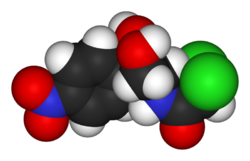Difference between revisions of "Chloramphenicol"
m (→Introduction) |
|||
| (8 intermediate revisions by 5 users not shown) | |||
| Line 1: | Line 1: | ||
| + | {{unfinished}} | ||
| + | {{toplink | ||
| + | |linkpage =WikiDrugs | ||
| + | |linktext =WikiDrugs | ||
| + | |sublink1 = Antibiotics | ||
| + | |subtext1 = Antibiotics | ||
| + | |pagetype = Drugs | ||
| + | }} | ||
| + | |||
| + | |||
[[Image: Chloramphenicol.png|thumb|right|250px|The 3D Structure of Chloramphenicol]] | [[Image: Chloramphenicol.png|thumb|right|250px|The 3D Structure of Chloramphenicol]] | ||
| − | + | ||
| − | Chloramphenicol orginates from cultures of ''Streptomyces'' and was one of the first antibiotics to be synthetically mass-produced. It is a dichloracetic acid derivative. | + | Chloramphenicol orginates from cultures of ''Streptomyces'' and was one of the first antibiotics to be synthetically mass-produced. It is a dichloracetic acid derivative. It's analogues florfenicol and thiamphenicol are discussed at the bottom of the page. |
| + | |||
==Mechanism of Action== | ==Mechanism of Action== | ||
| − | |||
==Spectrum of Activity== | ==Spectrum of Activity== | ||
| − | + | ||
| − | + | ||
==Pharmacokinetic Considerations== | ==Pharmacokinetic Considerations== | ||
| − | + | ||
| + | Chloramphenicol and analogues: Highly lipophilic neutral small molecules. | ||
| + | • Orally active. | ||
| + | • Very wide volume of distribution – penetrates across cell membranes readily – the data shown on the slide are for penetration into bronchial secretions. | ||
| + | |||
| + | Bronchial fluid is a transcellular fluid – what are the barriers for a drug to diffuse into this fluid? | ||
| + | |||
| + | • Hepatic metabolism (varies between species and with age) for chloramphenicol. | ||
| + | • A higher proportion of the administered dose of thiamphenicol and florphenicol are excreted unchanged in the urine. | ||
==Side Effects and Contraindications== | ==Side Effects and Contraindications== | ||
| − | |||
| − | |||
| − | |||
| − | |||
==Florfenicol and Thiamphenicol== | ==Florfenicol and Thiamphenicol== | ||
| − | |||
| − | |||
| − | |||
| − | |||
| − | |||
Revision as of 13:54, 24 October 2008
| This article is still under construction. |
|
|
Chloramphenicol orginates from cultures of Streptomyces and was one of the first antibiotics to be synthetically mass-produced. It is a dichloracetic acid derivative. It's analogues florfenicol and thiamphenicol are discussed at the bottom of the page.
Mechanism of Action
Spectrum of Activity
Pharmacokinetic Considerations
Chloramphenicol and analogues: Highly lipophilic neutral small molecules. • Orally active. • Very wide volume of distribution – penetrates across cell membranes readily – the data shown on the slide are for penetration into bronchial secretions.
Bronchial fluid is a transcellular fluid – what are the barriers for a drug to diffuse into this fluid?
• Hepatic metabolism (varies between species and with age) for chloramphenicol. • A higher proportion of the administered dose of thiamphenicol and florphenicol are excreted unchanged in the urine.
